PROTECT YOUR DNA WITH QUANTUM TECHNOLOGY
Orgo-Life the new way to the future Advertising by AdpathwayFor anyone who maintains a backyard bird feeder across the United States, the scene is a familiar one: a bustling hub of activity where birds of all shapes and sizes vie for a coveted spot at the banquet. Cardinals flash their brilliant red, chickadees flit in and out with remarkable speed, and jays might swoop in with their characteristic swagger. Yet, amidst this avian competition, there’s often one group of birds that seems to consistently dominate, out-eating their peers with surprising efficiency: the finches.
Whether it’s the cheerful, often aggressive House Finch (Haemorhous mexicanus), the bright yellow and black American Goldfinch (Spinus tristis), or the striped and streaky Pine Siskin (Spinus pinus), finches often appear to have an unfair advantage. They arrive in numbers, seem to stay longer, and appear to consume more seed than their share. But it’s not simply their abundance or their sometimes-feisty demeanor that gives them the edge. Finches, particularly the House Finch, employ a clever, often overlooked trick that allows them to maximize their feeding efficiency and, in effect, out-eat everyone else at the feeder.
This ingenious adaptation isn’t about brute force or intimidation; it’s about a highly specialized feeding strategy that capitalizes on a common feeder offering. Understanding this trick offers a fascinating glimpse into the evolutionary pressures that shape avian behavior and the subtle ways different species carve out their niche, even in the crowded environment of a backyard feeder.
The Feeders’ Main Attraction
To understand the finch’s trick, we must first consider the most popular and nutritious seed offered in U.S. bird feeders: black oil sunflower seeds (BOSS). These small, thin-shelled, high-oil content seeds are a favorite of a vast array of backyard birds, from chickadees to cardinals, jays, and, of course, finches. They are calorie-dense, providing essential energy for a bird’s high metabolism.
However, extracting the kernel from the shell requires a specific technique. Most birds use their beaks to crack open the shell, either by crushing it or by carefully manipulating it to split it open. This process, while seemingly simple, takes time and energy. And time at a feeder, especially a busy one, is a valuable commodity.
The Finch’s Clever Trick
Here’s where the finch’s genius comes into play. While most birds crack and then discard the shell, often dropping fragments or entire shells to the ground, finches, especially House Finches, possess an incredibly efficient and rapid de-hulling technique that gives them a significant advantage.
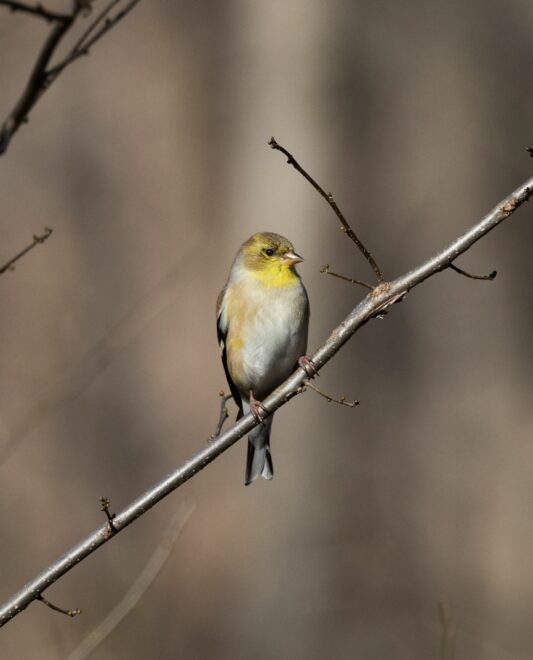 American Goldfinch by Jan Dommerholt
American Goldfinch by Jan DommerholtFinches have conical, strong beaks perfectly designed for cracking seeds. But their secret lies in the precision and speed with which they use their beak and tongue. A finch doesn’t just crush the seed. It typically grasps the sunflower seed along its length, positioning it precisely within a specialized groove on the inside of its lower mandible. With a quick, almost imperceptible flick of its tongue and a bite, it splits the seed open along its natural seam. Simultaneously, its tongue quickly separates the kernel from the shell fragments. The shell is then discarded, often with a rapid flick of the head, and the naked kernel is swallowed instantly.
The entire process – grasping, splitting, de-hulling, swallowing, and discarding the shell – happens in a fraction of a second. A single finch can process sunflower seeds at an astonishing rate, much faster than a cardinal or a chickadee, for example. This is particularly noticeable with House Finches, who are voracious and relentless at the feeder.
This de-hulling efficiency means that for every minute spent at the feeder, a finch can ingest a significantly higher volume of pure kernel (calories) compared to other birds that spend more time and effort manipulating the seed. It’s a highly streamlined assembly line for seed consumption.
The Benefits of Eating Faster Than Everyone Else
The consequences of this specialized de-hulling technique are profound for feeder dynamics.
More Calories Per Unit Time
This is the most direct benefit. Because they process seeds so quickly, finches extract more usable energy in less time. This allows them to fill up faster and consume a greater overall quantity of seed over a given feeding period.
Reduced Exposure Time to Predators
Time spent at a feeder is risky time, as birds are more vulnerable to predators like hawks or cats. By feeding faster, finches minimize their exposure, increasing their overall survival chances.
Dominance Through Efficiency
While House Finches can be aggressive, their dominance at feeders isn’t solely due to physical intimidation. Their sheer feeding efficiency means they can deplete the accessible seed before others have had their fill; this puts pressure on slower feeders, who might give up and move on.
Flock Feeding Strategy
Finches, especially House Finches and American Goldfinches, often feed in flocks. When multiple individuals are using this rapid de-hulling technique simultaneously, the feeder can be stripped of seeds in an incredibly short amount of time. This collective efficiency makes it challenging for solitary feeders or smaller groups of other species to compete. By separating the kernel so cleanly, finches also create less waste compared to birds that might drop more shell fragments or entire seeds during their less refined cracking process. This means more of the feeder’s contents are actually consumed by the finches themselves.
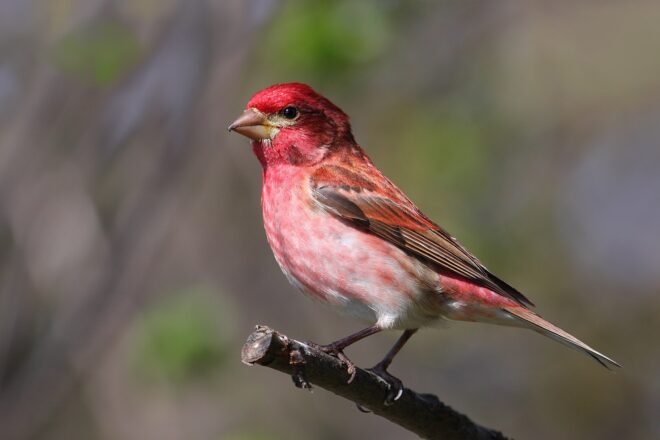 Purple Finch by Cephas
Purple Finch by CephasHouse Finch: The Backyard Conqueror
The House Finch provides a compelling case study of how this clever trick, combined with other opportunistic traits, allowed it to conquer new territories across the United States. Native to the Western U.S., House Finches were introduced to Long Island, New York, in the 1940s when captive birds were illegally released. From this small foothold they rapidly expanded across the East, heading westward and eventually meeting up with their Western counterparts and colonizing virtually the entire continental U.S. in just a few decades.
This rapid expansion was fueled by their incredible adaptability to human-modified landscapes, their preference for human-provided food (like bird feeders), and their generalist diet. They quickly became synonymous with backyard bird feeders, where their efficient de-hulling of sunflower seeds became a key to their success in these novel environments. Their ability to dominate these concentrated food sources was a major factor in their population explosion.
While efficiency is their primary trick, the House Finch’s sometimes aggressive nature complements this. They are known to squabble and chase away smaller, shyer birds, further solidifying their dominance at popular feeding stations.
 House Finch by Mathieu Landretti
House Finch by Mathieu LandrettiAmerican Goldfinch: The Finessed Feeder
The American Goldfinch, a beloved species famed for its vibrant yellow plumage (which changes by season) and undulating flight, also demonstrates remarkable feeding efficiency, particularly with its preferred seeds. Goldfinches have particularly slender, pointed beaks perfectly adapted for extracting the tiny seeds of thistle (Nyjer) and other composite flowers (read our guide on what goldfinches eat for more information). They are masters at manipulating these small seeds. While not a de-hulling in the same way as with sunflower seeds, their ability to rapidly strip seeds from flower heads or extract them from specialized Nyjer feeders is incredibly efficient.
Their agility allows them to cling to delicate seed heads or Nyjer socks, accessing food that larger, heavier birds cannot. This specialized niche minimizes direct competition for certain seed types. While their trick isn’t as universal as the House Finch’s sunflower seed strategy, the Goldfinch’s specialized beak and feeding behavior make them equally efficient in their chosen niche.
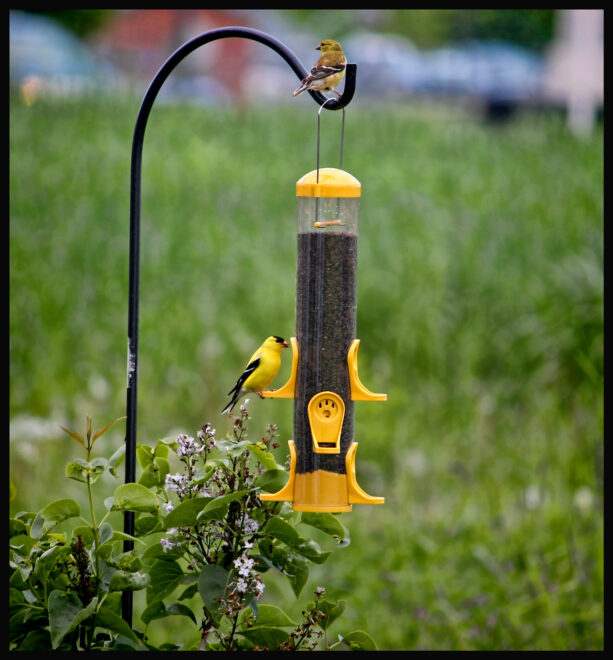 American Goldfinch by MJ Boswell
American Goldfinch by MJ BoswellPine Siskins: The Irruptive Eaters
Pine Siskins, often erratic winter visitors to many U.S. feeders, also employ rapid feeding techniques. In their natural habitat, siskins are adept at extracting seeds from conifer cones. Their fine, pointed beaks allow them to probe deep into cones. At feeders, they readily take sunflower seeds and Nyjer, and their quick, almost frantic feeding style, often in large flocks, showcases their high metabolic needs and efficient processing of seeds.
 Pine Siskin by Rhododendrites
Pine Siskin by RhododendritesImpact on Other Backyard Birds
The finch’s clever trick has a noticeable impact on other backyard birds. Birds that rely heavily on black oil sunflower seeds, such as chickadees, titmice, nuthatches, and cardinals, may find themselves outcompeted by the sheer volume and speed of finches, particularly House Finches. They might have to wait longer for a turn, or settle for foraging on the ground for dropped seeds. Some shyer species might visit feeders less frequently during peak finch activity, or opt for early morning/late evening visits when competition is lower. In areas with high finch populations, the rapid consumption of seeds can lead to feeders emptying much faster, requiring more frequent refills by humans.
What You Can Do to Balance the Feeder
While finches are fascinating in their efficiency, backyard birders typically want to ensure a variety of species can access their feeders. Here are some strategies to help achieve this.
Offer a Variety of Feeders and Seeds
Nyjer/Thistle feeders (mesh socks or tube feeders with tiny holes) are specifically designed for finches with small beaks (goldfinches, siskins, House Finches). Offering these separate feeders can draw some finch attention away from the general sunflower feeder.
Safflower Seeds
Many finches, especially House Finches, are less fond of safflower seeds than sunflower. Cardinals, grosbeaks, and Mourning Doves often enjoy safflower, which can be a good alternative to BOSS.
Peanut Feeders
Shelled peanuts attract jays, woodpeckers, and nuthatches, but are usually ignored by finches.
Suet Feeders
Suet attracts woodpeckers, nuthatches, chickadees, and wrens, providing a high-energy fat source that finches typically don’t dominate.
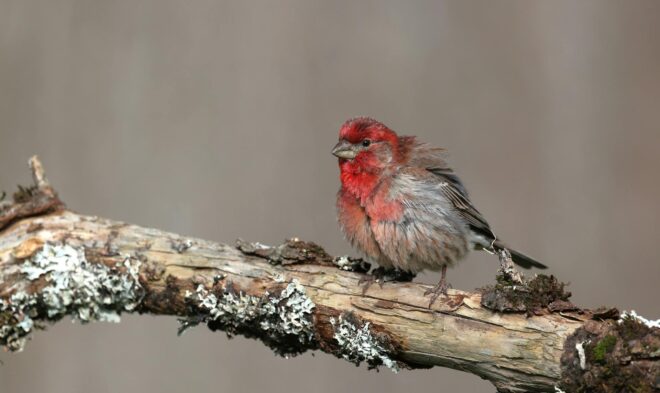 House Finch by Veronika Andrews
House Finch by Veronika AndrewsUse Weight-Activated Feeders
Some feeders are designed with perches that close off access to seed ports if a bird heavier than a certain weight (e.g., a cardinal or a finch) lands on them. This can deter larger birds while allowing smaller birds access.
Spread Feeders Out
If possible, place feeders in different areas of your yard, even on different sides of your house. This makes it harder for a single dominant finch (or flock) to monopolize all the food sources.
Ground Feeding
Scatter some seed (like cracked corn for Mourning Doves, juncos, and sparrows) on the ground away from the main feeder. This can draw some ground-feeding species away from the feeder itself.
Clean Feeders Regularly
Finch activity means more discarded shells and potential mess. Regular cleaning (at least every 2 weeks, more often in hot, humid weather) prevents mold and disease spread, especially important with high bird traffic.
 House Finch by Rhododendrites
House Finch by RhododendritesFinal Thoughts
The humble finch, particularly the ubiquitous House Finch, may seem like just another common bird, sometimes even a nuisance at the feeder. However, their ability to out-eat everyone else is not merely a matter of numbers or aggression. It’s a testament to a highly specialized and incredibly efficient de-hulling technique that allows them to extract maximum calories in minimum time from the most popular birdseed.
This clever trick is a prime example of evolutionary adaptation at play, showcasing how a specific physical trait combined with a behavioral strategy can lead to remarkable success in a competitive environment. So, the next time you watch a finch rapidly consuming black oil sunflower seeds at your backyard feeder, take a moment to appreciate the unsung genius of this little bird. It’s not just eating; it’s demonstrating a finely tuned survival mechanism that allows it to thrive, truly out-eating its way to dominance in the avian world.




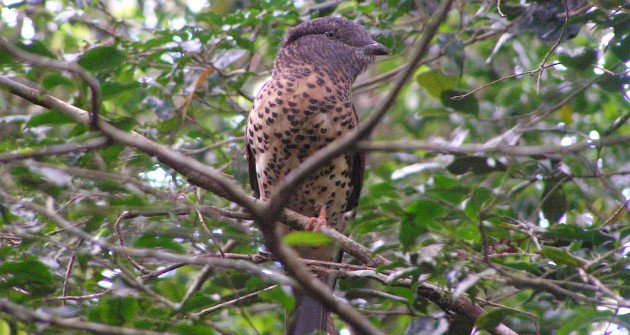


















 English (US) ·
English (US) ·  French (CA) ·
French (CA) ·